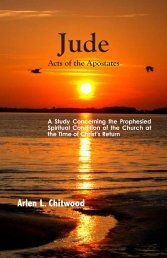Signs in John's Gospel - The Lamp Broadcast
Signs in John's Gospel - The Lamp Broadcast
Signs in John's Gospel - The Lamp Broadcast
You also want an ePaper? Increase the reach of your titles
YUMPU automatically turns print PDFs into web optimized ePapers that Google loves.
<strong>The</strong> Wedd<strong>in</strong>g Festivities 71<br />
order of Melchizedek,” follow<strong>in</strong>g the battle of the k<strong>in</strong>gs (follow<strong>in</strong>g<br />
the tread<strong>in</strong>g of the w<strong>in</strong>epress), with bread and w<strong>in</strong>e, to bless<br />
Abraham and his descendants through Isaac and Jacob (cf. Ps.<br />
110:1-4; Heb. 4:6, 10; 7:1ff).<br />
And, exactly as seen <strong>in</strong> John chapter two, the w<strong>in</strong>e which<br />
Christ and His disciples will aga<strong>in</strong> dr<strong>in</strong>k together <strong>in</strong> that day will<br />
not be just any w<strong>in</strong>e. As described by the steward of the feast <strong>in</strong><br />
Cana, it will be “the good w<strong>in</strong>e,” which will have been kept “until<br />
now” (cf. Isa. 25:6; Joel 2:22; 3:17, 18).<br />
<strong>The</strong> w<strong>in</strong>e which Christ made at the wedd<strong>in</strong>g festival <strong>in</strong> Cana<br />
was a type w<strong>in</strong>e which man could not have produced at this time;<br />
nor could man produce this type w<strong>in</strong>e today. A w<strong>in</strong>e of this nature<br />
though, <strong>in</strong> all likelihood, existed <strong>in</strong> the antediluvian world. That<br />
is the clear implication from Noah, follow<strong>in</strong>g the Flood, plant<strong>in</strong>g<br />
a v<strong>in</strong>eyard, mak<strong>in</strong>g w<strong>in</strong>e, and becom<strong>in</strong>g drunk (Gen. 9:20, 21).<br />
Atmospheric conditions preced<strong>in</strong>g the Flood were entirely<br />
different than they were follow<strong>in</strong>g the Flood. At the time of the<br />
Flood, the waters which God had placed above the atmosphere<br />
when he restored the earth (Gen. 1:6-8) were released and fell<br />
through “the w<strong>in</strong>dows [contextually, ‘flood gates’] of heaven”<br />
upon the earth, form<strong>in</strong>g part of the waters which flooded the<br />
earth (Gen. 7:11ff).<br />
This allowed the sun’s rays to sh<strong>in</strong>e directly through the<br />
atmosphere, result<strong>in</strong>g <strong>in</strong> accompany<strong>in</strong>g changes, particularly<br />
meteorological changes.<br />
And these changes apparently resulted <strong>in</strong> someth<strong>in</strong>g new and<br />
unknown to Noah when he made w<strong>in</strong>e follow<strong>in</strong>g the Flood — a<br />
w<strong>in</strong>e which, rather than mak<strong>in</strong>g “glad the heart of man,” <strong>in</strong>stead,<br />
resulted <strong>in</strong> drunkenness.<br />
(For <strong>in</strong>formation particularly on meteorological changes at this<br />
time, refer to the author’s book, PROPHECY ON MOUNT OLIVET,<br />
Chapter IX.)<br />
<strong>The</strong> only type w<strong>in</strong>e which Christ would have produced <strong>in</strong> John<br />
2:7ff — described <strong>in</strong> Ps. 104:15 — was evidently a type w<strong>in</strong>e which<br />
Noah thought that he was mak<strong>in</strong>g follow<strong>in</strong>g the Flood but could<br />
no longer produce. And drunkenness, associated with w<strong>in</strong>e fol-



